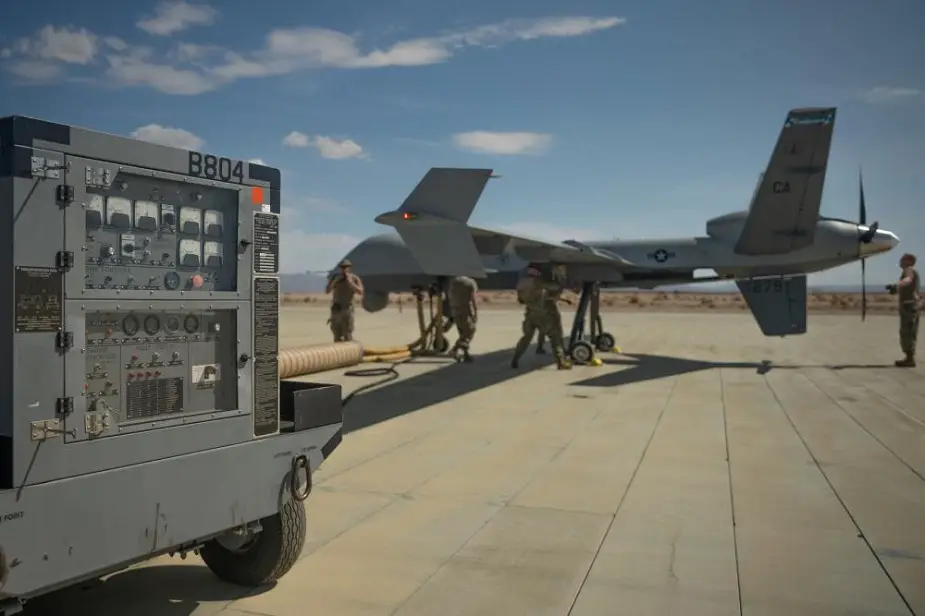Breaking news
US Marines provide aviation delivered ground refueling to US Air Force MQ-9 Reaper drone.
U.S. Marines with Marine Medium Tiltrotor Squadron (VMM) 764 provided aviation delivered ground refueling to a remotely piloted MQ-9 Reaper drone from the 163rd Attack Wing of the California Air National Guard during Integrated Training Exercise 4-22 at Marine Corps Air-Ground Combat Center, Twentynine Palms, Calif., July 20 and 21, 2022.
Follow Air Recognition on Google News at this link
 The MQ-9 Reaper received fuel via aviation delivered ground refueling from an MV-22 Osprey with Marine Medium Tiltrotor Squadron 764, marking the first time the MQ-9 received fuel from a joint asset and the first time an Air National Guard MQ-9 received fuel from another aircraft. The MQ-9 Reaper provided close air support to Marine Air-Ground Task Force 23 during its execution of the fire support coordination exercise of ITX as the Marine Corps Reserve continues to work to integrate with sister services in preparation for future operations(Picture source: US Marine Corps / Lance Cpl. Jennifer Delacruz)
The MQ-9 Reaper received fuel via aviation delivered ground refueling from an MV-22 Osprey with Marine Medium Tiltrotor Squadron 764, marking the first time the MQ-9 received fuel from a joint asset and the first time an Air National Guard MQ-9 received fuel from another aircraft. The MQ-9 Reaper provided close air support to Marine Air-Ground Task Force 23 during its execution of the fire support coordination exercise of ITX as the Marine Corps Reserve continues to work to integrate with sister services in preparation for future operations(Picture source: US Marine Corps / Lance Cpl. Jennifer Delacruz)
The airmen from the 163rd Attack Wing integrated with Marine Air-Ground Task Force 23 to provide close air support during the fire support coordination exercise, which tests a MAGTF’s ability to conduct complex coordination of multiple fires assets in support of maneuver forces.
This marked the first occurrence of U.S. Air Force MQ-9 Reapers being refueled by a joint platform and only the second time an MQ-9 received fuel from another aircraft, according to U.S. Air Force Maj. Shanna Ream, assistant director of operations for the 163rd Attack Wing. The training also allowed the 163rd Attack Wing to practice “Reaper ACE,” or “agile combat employment,” which shifts operations from centralized physical infrastructures to a network of smaller, dispersed locations.
Ream explained that the MQ-9 has been dependent on a large footprint overseas to launch and recover the aircraft. The Joint Force will likely not have the ability to establish large air bases overseas in future conflicts, which requires adaptation in the employment of the MQ-9 platform.
“Now we're making it expeditionary where we can hop to different places with a very small footprint, refuel, rearm, get back up in the air and continue supporting,” said Ream.
This training and integration is essential to both the U.S. Air Force and Marine Corps as the services continue to search for ways to be more agile, lethal and expeditionary. The Marine Corps is also procuring the MQ-9 and will look for ways to employ the aircraft with as small of a footprint as possible in support of Force Design 2030.
“Working with the Marine Corps is very important because the Marine Corps just acquired the MQ-9. So a lot of those tactics, techniques and procedures… we're helping to develop that,” said Ream.
The 163rd Attack Wing participated in Integrated Training Exercises in the past, but had not integrated to this level, receiving aviation delivered ground refueling, coordinating with U.S. Marine Corps F/A-18s and directly supporting ground maneuver forces.
As the Marine Corps Reserve continues to work towards goals established in Force Design 2030, integration with Joint Forces will continue to be a priority in future training exercises.


























